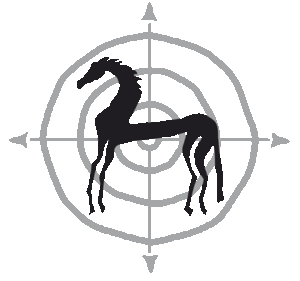The 1 question we should ask about riding horses in hyperflexion (‘rollkür’)
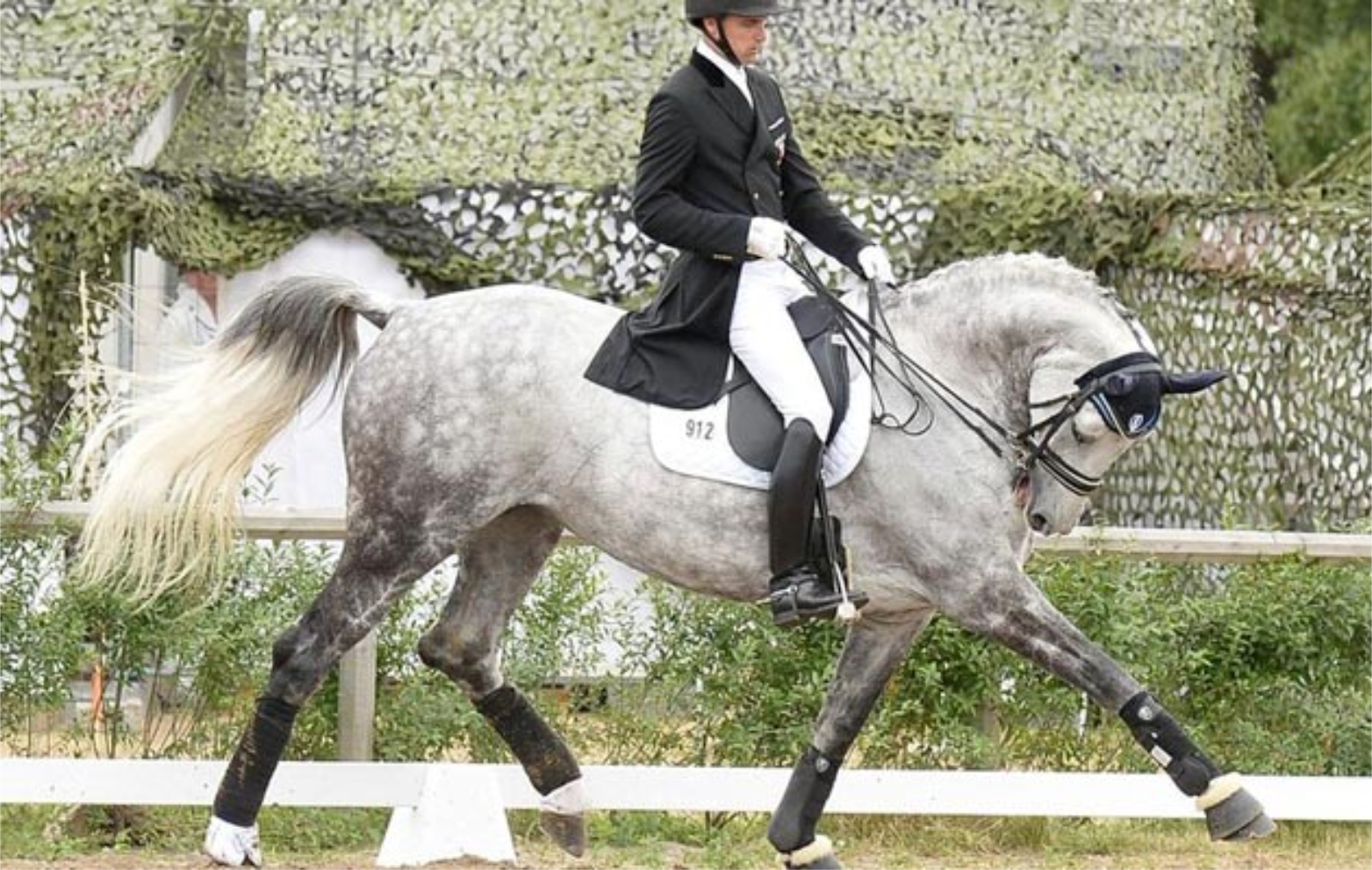
The 1 question we should ask about riding horses in hyperflexion is:
WHY do riders do this?
Hyperflexion (also known as ‘rollkür’) has been a hot potato issue in horse sport for many years now. The discussions have mostly been related to dressage. But the training method itself is used by riders from every discipline: jumping, eventing, western, and so on.
What is ‘Rollkür’?
Hyperflexion or Rollkür means that horses are ridden very ‘curled up’, with their nose pulled towards their chest.
Horses ridden in this way usually show clear signs of distress. Such as:
Tense faces. Ears laid back. Angrily swishing tails. Gaping mouths (if not strapped close with a heavy noseband). Grinding teeth. Weird muscle development. Unnatural gaits, ‘throwing their legs out’ like a soldier on parade.
You don’t need to be a horse expert to see that horses don’t like being ridden this way.
(Ironically, it seems like it’s MORE difficult for some people who actually are horse experts to see the problem…).
And it is certainly a long way from being the true partnership with a horse which most of us try to achieve.
There has been some research done into riding horses in hyperflexion.
Most studies clearly show that this way of riding has negative effects on horse health and horse welfare.
But hyperflexion is still being used at stables and competition grounds all over the world.
Most riders love their horses and certainly don’t want to harm them.
Therefore, the nr. 1 question we should ask about riding horses in rollkür is: WHY do riders ride their horses in this way?
In this post, we will look into the 3 main reasons why riders use this technique.
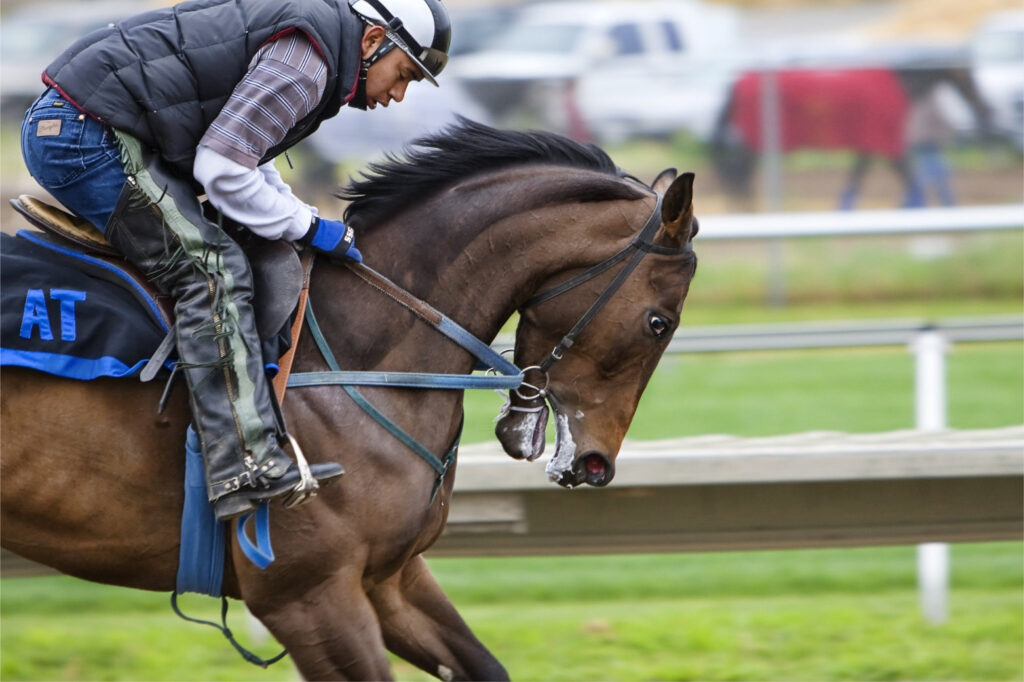
The use of hyperflexion/rollkür is usually associated with dressage. But the technique is also seen in many other equestrian disciplines. This is a racehorse in draw reins.
Reason 1: Lack of knowledge
Some riders just don’t know better. Maybe every rider in their stable is riding this way. Which makes them think that this extreme overbending is the only way to train a horse.
Or they see some top riders doing it – so they think it must be something good. Maybe even the only way to ‘get to the top’.
Also, most horse training is not black and white. It’s not always easy to see and feel what is good, and what is wrong.
For example, a young or unbalanced horse might for a few seconds come behind the vertical (move its nose towards its chest). Not perfect – but that doesn’t mean it is hyperflexion.
On the other hand, a rider who habitually trains his/her horse in hyperflexion at home and in competition warm-up, might ride their horse with his nose a bit more forward during the competition itself. Meaning, all looks fine from the outside… even if it isn’t!
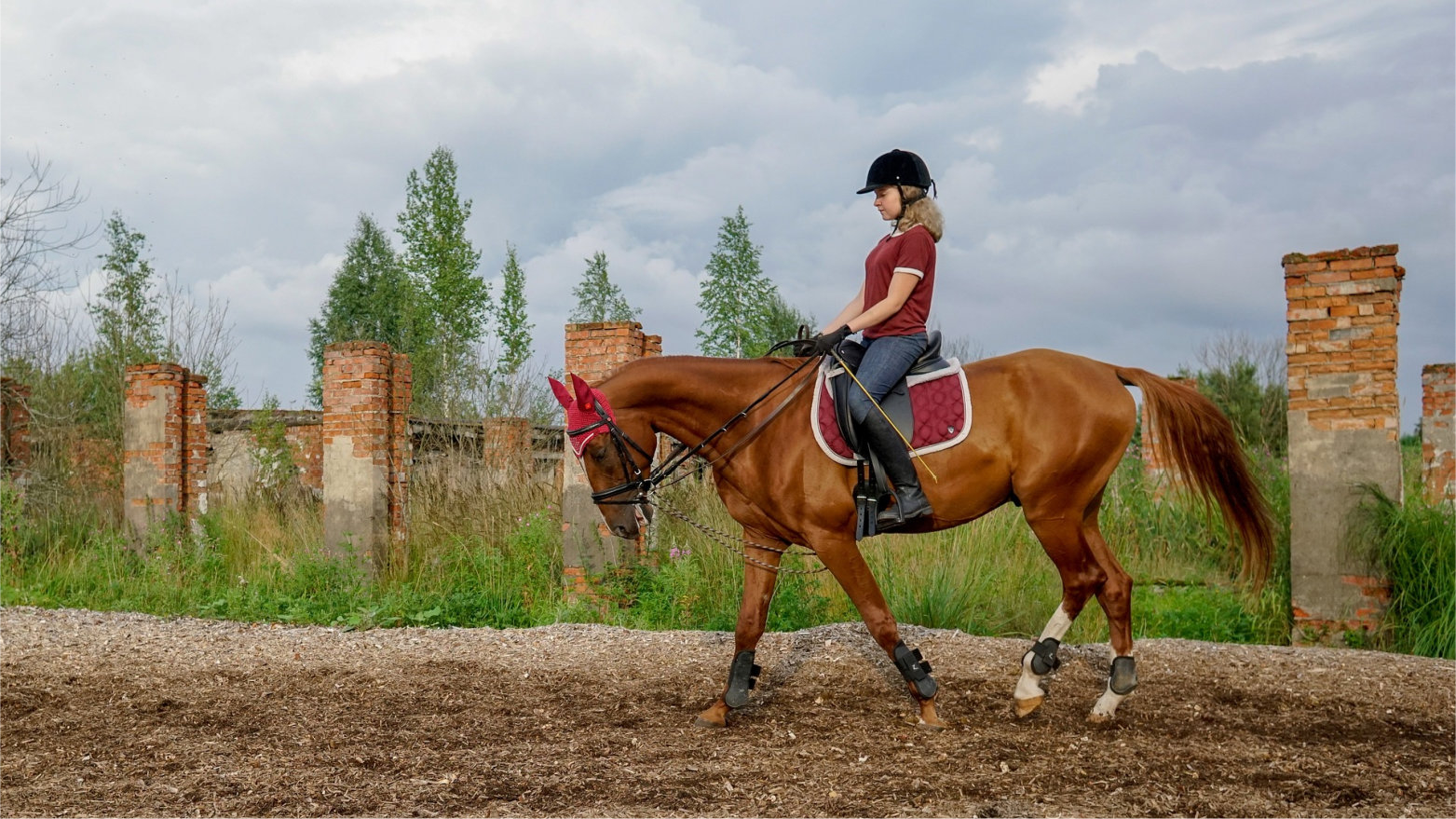
Some riders think that riding their horse in hyperflexion (with the head pulled towards the chest) is the way horses should be trained. Maybe because they see other riders doing it?
The remedy for lack of knowledge: Education
The remedy for lack of knowledge seems easy: give riders more knowledge and information.
Coaches and riding teachers must teach their students what is right and what is wrong – and most importantly, why it is wrong.
However, this also means that the teachers themselves first must learn it correctly.
Meaning that it is necessary that there are very clear guidelines in all schools/institutions where riding teachers are educated.
And to get that in place, there must be very clear and strong rules and guidelines set by the national horse organizations in every country.
The challenge for riding instructors and coaches
Many riding instructors work as freelancers. And there will always be students who are just looking for a ‘quick fix’ instead of putting in the time and effort to learn to ride and train their horses correctly.
If you want to do a good and ethical job as an instructor, you might lose those ‘quick fix’-clients. And with that, part of your income.
But if ALL instructors are against the use of hyperflexion, then those quick-fix clients will have nowhere to go…
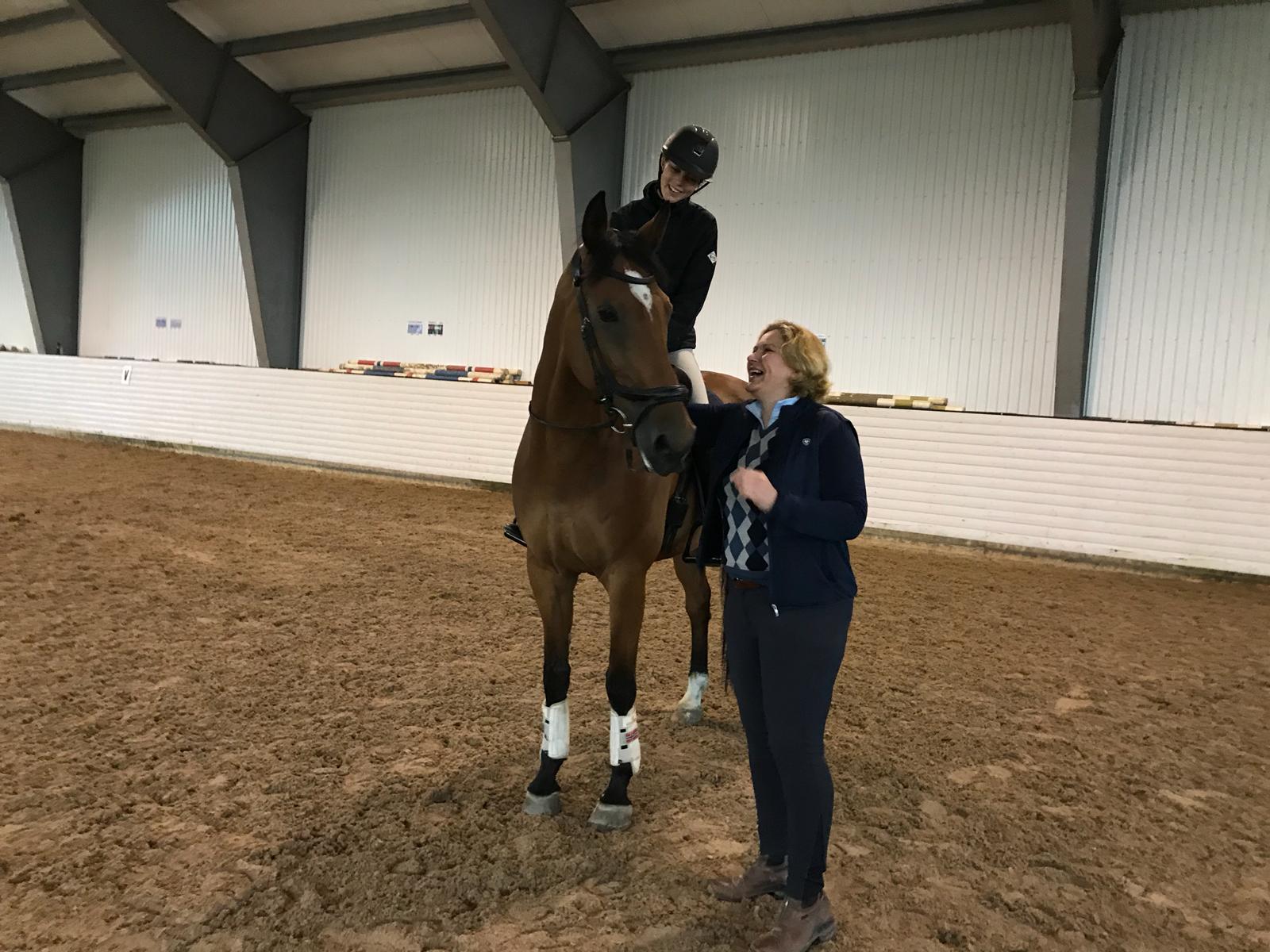
(Most) riding instructors love students who are willing to put their horse first.
The role of journalists and social media
Not all people writing about horses and horse training have in-depth knowledge about these subjects.
It’s much easier to write about the results of a dressage competition, for example, or to post some pretty pictures, than to give a thorough analysis of why one dressage test was better than another. And what that might say about how the horse was trained.
Also, there are not so many dedicated horse publications in the world – most of them exist in countries where horse riding traditionally is a big sport.
Those publications are usually highly dependent on income from advertising. And it can be tempting to not write about controversial issues, in order not to lose advertisers.
Unfortunately, this means that we cannot expect horse magazines (paper or online ones) to always give ‘the real story’. And the same thing goes for posts on Instagram, TikTok and such.
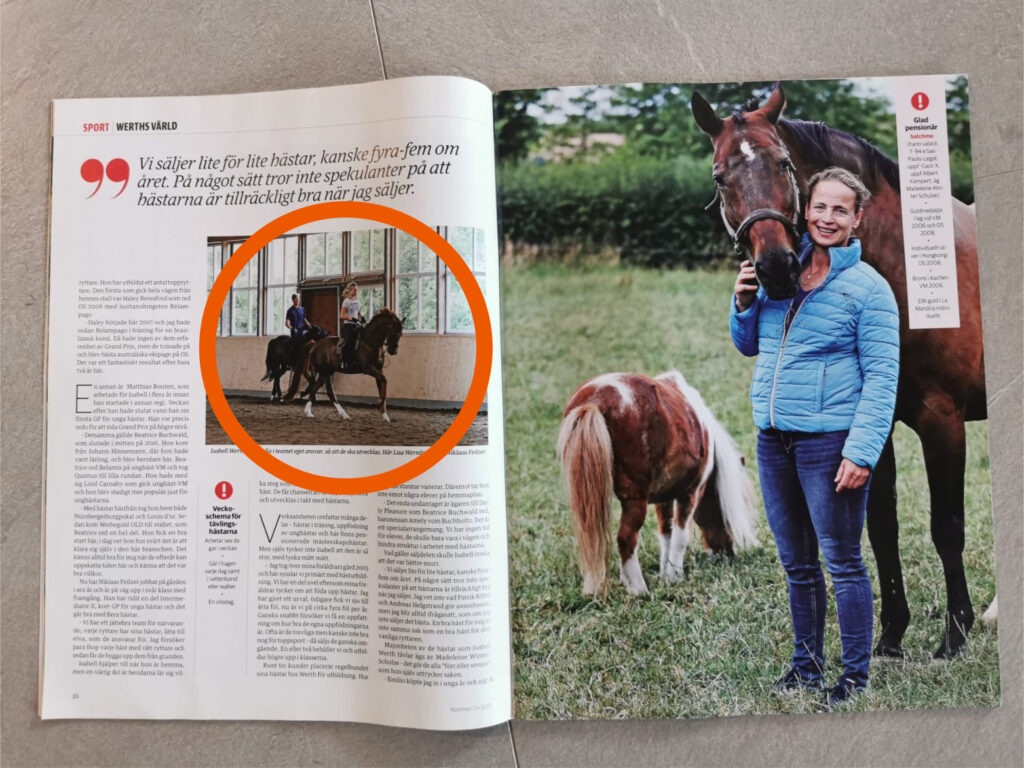
These are pages of a well-known Swedish horse magazine from 2018. They show an interview with Isabell Werth, one of the top dressage riders in the world. One of the pictures shows two of her riders training horses in the indoor arena. Should a horse magazine show pictures of horses ridden in hyperflexion?
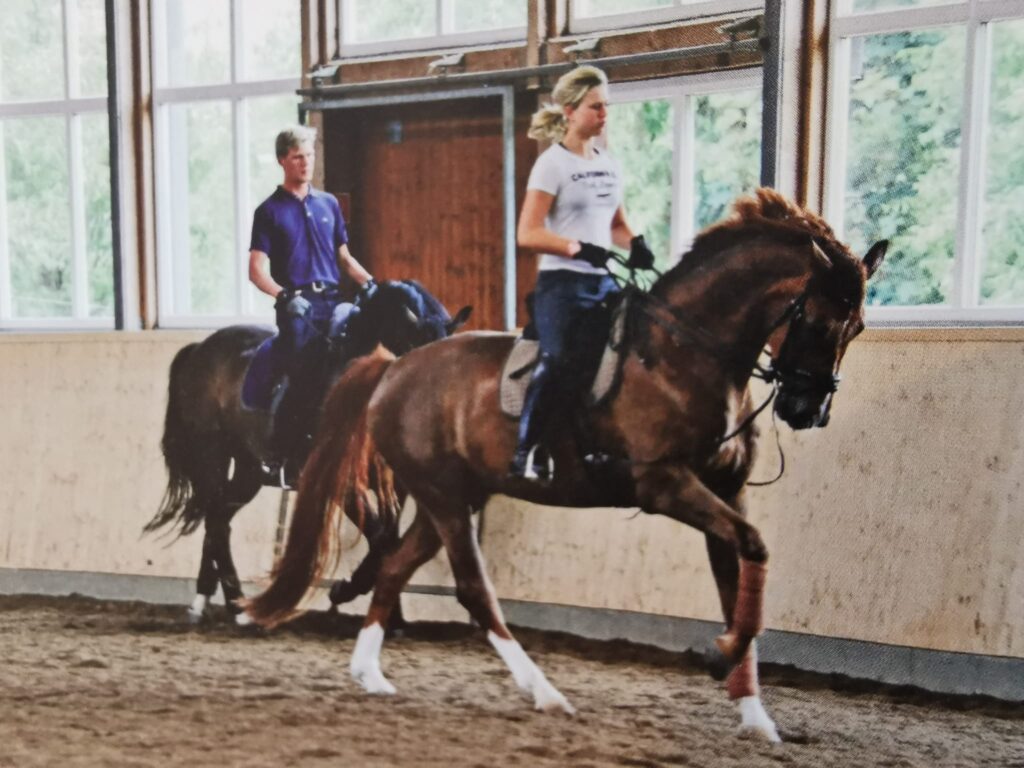
When studying that picture closer, it is clear that the first horse is being ridden in hyperflexion, with the use of draw reins. The horse behind is partly hidden but still seems to be ridden at least overbent. The question is: why is a reputable horse magazine publishing such a picture? Does that imply that they are approving of this kind of riding? Or are they worried about damaging their relationship with the interviewed person?
Reason 2: Time and money
It takes time and skill to train a horse correctly. It will take years before a horse is ready for the highest levels of dressage and jumping. Even if the horse is very talented.
If you do not give your horse enough time, he most likely will develop a lot of problems. In his body, for sure, and many horses also get mental problems if there is too much pressure in their training.
Some riders use rollkür as a shortcut to save time. This especially applies to professional riders and horse dealers. The horse is continuously pushed and forced towards higher levels of training and competition – because then it can be sold as quickly as possible, and for a higher price.
The damage caused by riding in hyperflexion is not always immediately noticeable. Especially in young and talented horses, it might take some time before the first problems show up.
Therefore, for many professional riders, it is very tempting to go for the ‘quick fix’. Because by the time the horse will start showing problems, it will have been long sold anyway.
How do professional riders get away with hyperflexion?
Unfortunately, these days there are quite a few top riders who use hyperflexion. At home/during training (see the picture above), and even in competition.
How do they get away with this?
In the higher levels of showjumping, there are no extra points given for style. The only thing that matters is that you finish the course without penalties, in whatever way. Regardless of how you ride, or how you train your horse.
In dressage, HOW you do things is very important. All the rule books state that the horse should be correctly trained, cooperative, and seemingly do things of its own free will (not forced and bullied).
But sadly, dressage judges these days are often looking more for a test that is ‘spectacular’ instead of correct. Even if the horse with the most flamboyant movement clearly has not been correctly trained, and even if that horse is showing clear signs of distress.
Because of that, there is not much of an incentive for top riders who use hyperflexion to change their ways. After all, why would they – as long as they get high percentages in their tests anyway??
The video below (German language) is about the lack of horse welfare controls at the CHIO in Aachen in 2019. This is one of the biggest and best known horse competitions in the world. It shows several top riders riding their horses in hyperflexion.
How to stop riders who ride rollkür on purpose
The only way to stop riders who use this abusive ‘training’ technique on purpose is simple: don’t let them get away with it!
What needs to be done:
All international and national horse organizations must make it very clear in their rules what exactly hyperflexion is, and that it is not allowed under any circumstances. (Just like they should make a clear point of this in all places where riding instructors get their education.)
Rules against this must be very strictly enforced by the stewards and judges at ALL competitions, and at every level. (If a professional rider risks being sent home for warming up in rollkür, for example, it will certainly make them think.)
This means that both judges and stewards also need training and support from their national horse organizations, to be able to do this job.
Good horse journalists and social media also have a big role to play here.
Write about it – and keep writing and posting about it!
Keep explaining why this is wrong, and what it does to a horse.
Maybe most importantly: stop writing positively about riders who use hyperflexion – even if they win medals…
Would we speak positively about dog trainers who tie up and abuse their dogs, even if they win at competitions? Of course not. So, why should this be different for horse riders and trainers?
Reason 3: Fear
There are a lot of great horses around these days. Well-bred, from the best sport horse bloodlines.
They are often tall, with big movements, very athletic and with lightning-quick reflexes. Since they are bred to be top sport horses, they are often very sensitive and ‘hot’.
For most breeders, the dream (and the biggest potential for profit) is to breed such top-class competition horses. And those horses are meant to be ridden by professional riders.
The challenge here is that not every rider is a professional. And even professional riders are not always good riders. Also, a professional rider has to be careful: if they get bucked off and break a leg, they will lose a lot of their business.
It takes a lot of skill, energy, strength and often plain courage to ride these top-class horses.
And it can be very tempting for the rider to use hyperflexion as a way of feeling that you are in control. Often combined with harsh bits, draw reins, sharp spurs, very tight nosebands, and so on.
I know myself that I am tempted to ride my horses a little bit rounder, a little bit deeper, if I fear they will spook or ‘explode’. And for no amount of money would I be tempted to ride some of the horses I see around these days: too nervous, too ‘hot’, too spooky.
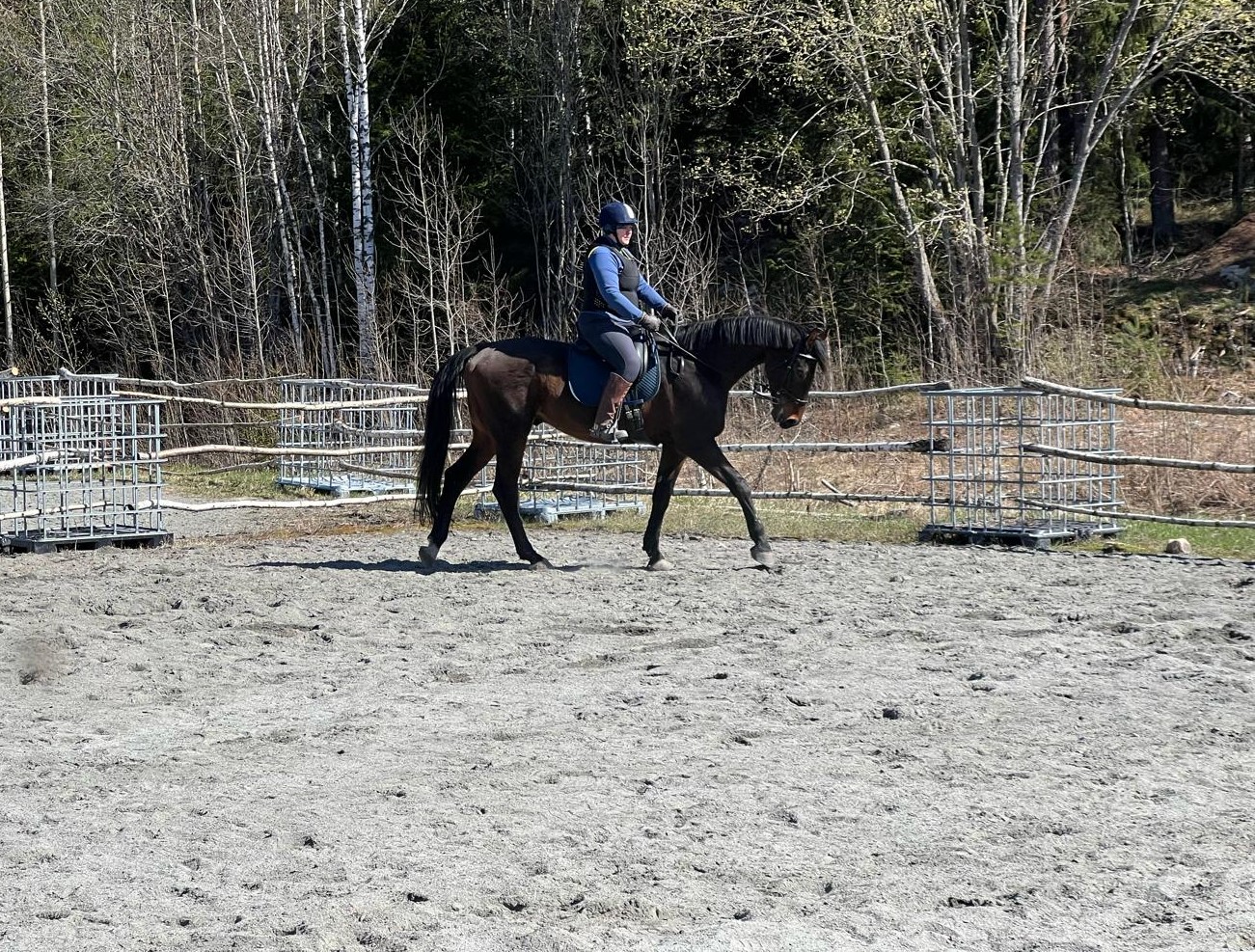
I know that I can be tempted to ride some horses a bit too deep and round, if I fear that they might spook or jump. Especially if they are very big and powerful!
The solution: Better horse keeping
Even the world’s best athlete is still a human, and not a robot.
Even the most expensive horse in the world is still a horse. And still has the same needs as every other horse: freedom to move, appropriate food, the company of other horses.
Instead, we do the opposite. Often horses are locked up in ‘solitary confinement’ for many hours a day. And they get too little hay, and too much concentrated food. No wonder many horses are stressed, nervous, difficult to ride and get stomach ulcers.
Horses that are kept in more natural living conditions are usually a lot more relaxed. And then the rider might not feel the need to use rollkür as the only way to control their horse.
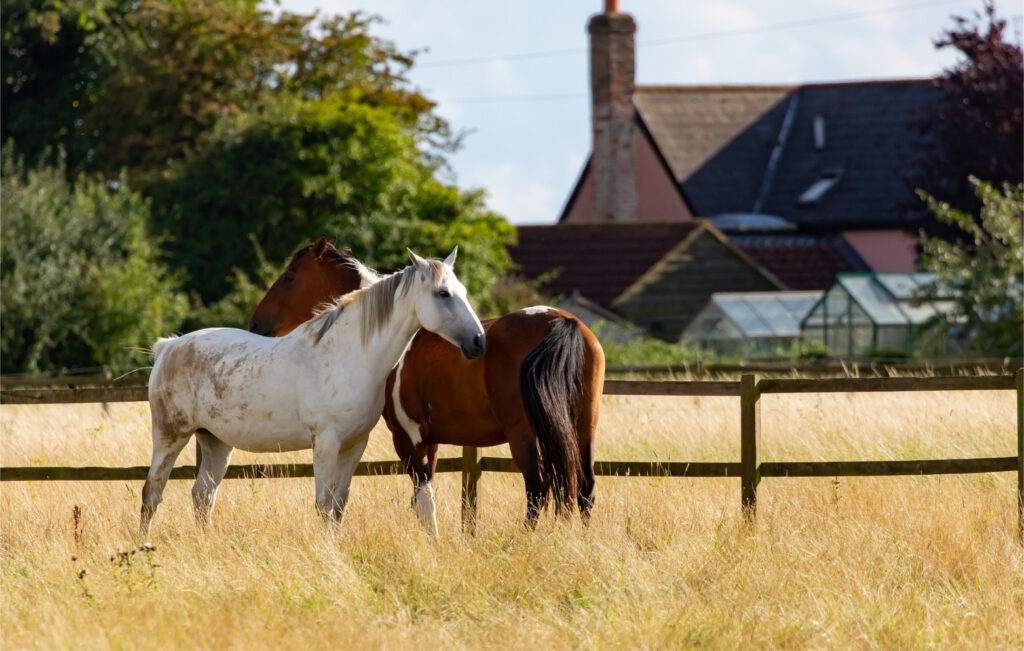
Want a more relaxed horse? Give him enough space to move, lots of fresh air and company.
Are you a horse lover? Then step up!
You are reading this post – which mean you are probably a horse lover.
All of us who love horses have to step up, and make it clear we are against all kinds of abusive horse training.
So, what can we do?
- We can educate ourselves. We must learn to see what is good horse training, and what is abusive.
- We can use riding instructors who have better solutions – and we can refuse to use riding instructors who teach abusive methods. (Even if they are well-known and popular…)
- We can start – and continue – discussing it. If you see somebody using hyperflexion, or a tight noseband – ask them why they do this. Do ask in a non-aggressive way, and really listen to their reasons.
- Organize a session at your stable and invite an expert to discuss this training method. Maybe combined with an actual training session under saddle, to show how things can be done better. It’s also possible to just show one of the films that give good information about the issue.
- We can start calling it out. If you see riders at a competition using this during warm up or even during the competition: talk to the stewards and the organizers, and post about it on social media.
- On social media, like and follow people who are setting good examples. Unfollow those who treat their horses unfairly.
- Maybe the most important thing we can do: Write to your national horse organization and ask how they will safeguard horse welfare in their rules and regulations, and if the rulebook maybe urgently needs some improvements? Let them know you care!

Use the power of social media – and the power of the pen – to stop hyperflexion. You can post about riders who use rollkür at competitions. You can follow influencers who set a better example. And write to your national horse organization!!
Don’t miss our next blog post!
Don’t risk missing out – sign up here, and our next blog posts will automatically land in your inbox.
BONUS: you will get this FREE E-BOOK! With 10 easy tips how you can be a better rider, already today. Because our horses deserve that we are the best riders we can be.
Any questions or comments? Feel free to share with us in the comments.
We love feedback and will try to get back to you as quickly as possible.
